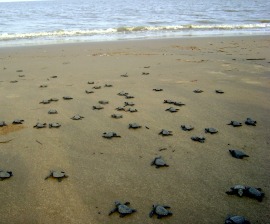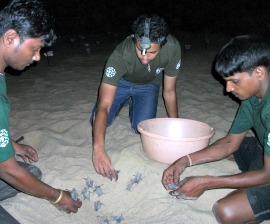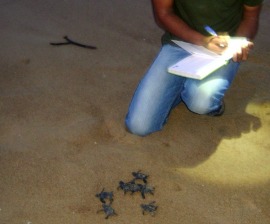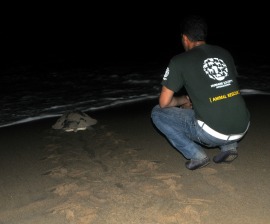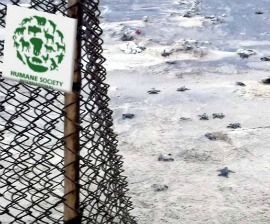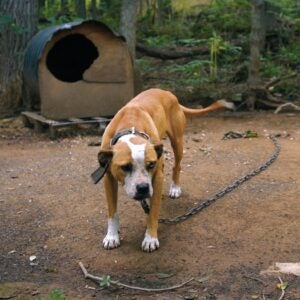-

iStock
今でも世界中で、口紅やシャンプーなどの化粧品の試験のために、実験施設で動物が苦しめられ、犠牲になっていることを知っていますか? 動物の口から無理やり化学物質を流し込んだり、点眼したり、また剃った皮膚に物質を塗布したりして、試験が行われています。これが、ヒューメイン・ソサイエティー・インターナショナル(Humane Society International、HSI)の#BeCrueltyFree思いやりのある美しさキャンペーンが終わらせようとしている、化粧品産業の醜い現実です。
Q: 化粧品の「cruelty-free」 (動物に苦痛を与えない)とはどういうこと?
A: 「Cruelty-free」な化粧品企業とは、安全かつ人道的な技術革新に取り組んでおり、1) 化粧品の完成品及び原料の安全性を確立させるための新たな動物実験の実施・委託、2) 動物実験なしには人間での安全性を確保できないような新たな原料*の使用、3) 新たな動物実験が必要である国における化粧品の販売、の3つを廃止する「期限」を設定している企業のことです。(「新たな原料」とは、企業が定めた期限の後に初めて化粧品のために開発された、または用いられた、新たな化学的物質を指します。)
Q: 化粧品の動物実験にはどのような動物が使われているの?
A: 世界中で、毎年10万~20万匹の動物が、化粧品のために苦しみ犠牲になっていると推定されます。これらの動物には、ウサギ、モルモット、ハムスター、ラットやマウスなどが含まれます。イヌやサルは、どこの国でも化粧品の試験のためには使われていませんが、その他の化学物質の試験において用いられています。
Q: 化粧品にはどのような動物実験が行われているの?
A: 一般的に、化粧品の動物実験には、毛を剃ったウサギの皮膚に物質を塗りこむ皮膚刺激試験や、物質をウサギの目に点眼する眼刺激試験や、ガンや出生異常等の病気や健康被害の兆候を確認するための、数週間から数か月に及ぶ強制経口投与を行う研究や、大量の試験物質を強制経口投与し致死量を確認するための、非難が絶えない「急性毒性試験」などが含まれます。これらの試験は、動物を失明させたり、目の腫れ、皮膚の腫れや出血、内出血、臓器の損傷、出生異常やけいれんなどを引き起こし、そして最終的には死に至るなど、動物にとって著しい苦痛を伴う場合があります。試験が終了すると、動物は通常は窒息、首の骨を折る、断頭などの方法により処分されます。鎮痛のための処置は通常行われません。動物実験の種類については、詳しくはこちらをご覧ください。
Q: 法的に義務付けられていないのに、何故企業は動物実験を実施しているの?
A: ほぼ例外なく、動物実験を実施するか否かの選択は企業にゆだねられています。ほとんどの場合、企業が「新規」原料を開発し、使用したいという理由で動物実験が選択されます。新規原料とは、新しいために既存の安全性に関するデータがない原料のことを指します。なので、規制上、製品を販売する前に新たな安全性データを収集する必要があり、そのために動物実験が実施されるのです。
企業は何故動物を用いない代替法を使用しないのでしょうか。動物を用いない優れた試験方法が多く存在するので、多くの試験要件については、動物実験ではなく代替法が使用可能です。しかし、現時点で、新規原料のために必要なすべての試験の種類について代替法が開発されているわけではないのです。代替法の開発が遅れている背景として、今まで何年もの間、動物を用いない代替法の開発が優先されてきておらず、また代替法の新規開発には時間がかかるということが挙げられます。進展は着実にありますが、このような経緯からまだ全て代替法で対応できる段階には至っていません。このため、代替法がない試験に関しては、動物実験が実施されています。
現存する何千もの既存の原料のみを使えば、企業は新たな動物実験を回避できます。Cruelty-Freeな企業はこのように動物実験をせずに製品を製造しているのです。
また、動物実験は化粧品業界において長年の習慣であるという理由もあり、続いています。化粧品にはずっと動物実験が使われてきていて、限界があってもやり慣れた方法であるということから続けられているのです。化粧品の販売を許可する規制当局関係者はとても保守的なアプローチをとっていることが多く、扱い慣れていない動物を用いない試験方法で得た安全性データを企業が提出すると、承認作業に遅れが生じることもあります。HSIは、最新の動物を用いない試験方法への理解とその受け入れを促進するために企業や規制当局に働きかけています。
また、中国など自国に輸入している企業に対して法的に動物実験を義務付けている国で販売しているために動物実験を続けなければならないと主張する企業もいますが、これらの企業は、中国で販売するということは新たな動物実験を実施する必要が生じるということを知った上で、中国で販売することを自ら選択しているという状況にあります。ラッシュやポールミッチェルなど、真にcruelty-freeな企業は、動物実験の法令が改正されるまで中国では販売しないと宣言しています。
苦しむ動物たちを救うため、アクションとご支援をお願いいたします。
Q: これらの動物実験には、科学的な限界はあるの?
A: あります。同じ物質にさらされても、異なる動物種の場合、異なる反応を示すこともあるため、動物実験には、科学的限界もあります(ということは、ヒトとその他の動物の反応は異なる場合があるということです)。したがって、動物実験の結果は、人間に対して適用できない場合もあり、実生活において人間に及ぼす被害を過小評価もしくは過大評価してしまうこともあります。加えて、動物実験の結果は変化しやすく、解釈が難しいということもあります。信頼性が低く、予測が困難な動物実験は、消費者の安全性を保証するためには十分ではないということになります。
動物実験のほとんどは、毒性のメカニズムについて基本的かつ荒削りな知識しか持っておらず、種の違いが試験結果に及ぼす影響やその重要性について理解していなかった1930年代に開発されたものなので、動物実験の科学的な信頼性が不十分であることにはうなずけます。動物実験の科学的限界について、詳しくはこちらをご覧ください。
Q: 動物実験の代替にはどのようなものがあるの?
A: 化粧品企業は、今すぐに動物実験を廃止しても、cruelty-freeな方法を活用し、新しく、かつ安全で楽しい美容化粧品を製造することができます。Cruelty-freeな方法には次のようなものがあります。
• 企業は、数千種類も存在する、長い間安全に使用してきた実績のある原料を使うことができます。これらの原料に対しては、すでに安全性のデータが存在するため、新たに試験を実施する必要がありません(動物実験もその他の試験も必要ありません)。
• 企業は、ヒトが化学物質に対してどのように反応するか、動物実験よりもより正確に予測できる最先端の動物を用いない安全性試験を活用することができます。40以上の動物を使わない試験方法が利用できると評価されており、これらの最新の代替法のほうが、動物実験よりも、より安価で効率が良く、人間により適用できる結果を生み出します。最先端の動物を使用しない試験方法は、最新の科学的技術が提供するものであり、時の流れにより古くなりつつある時代遅れの動物実験に取って代わるものであるからです。例えば、EPISKIN、EpiDermやSkinEthicのような人間の肌を再構築したものを用いた皮膚試験もいくつかあります。また、太陽の光により誘発される光毒性のための「3T3 NRU」試験や目の腐食試験のBCOP試験等があります。代替法について、詳しくはこちらから。
上記のアプローチは、cruelty-freeな企業を認証する国際的に認められたプログラムであるリーピング・バニー(Leaping Bunny、英文のみ)に認証された企業がとっているアプローチです。
Q: 日本では化粧品の動物実験は法的に義務付けられているの?
A: いいえ。日本の法令では、一般化粧品については特段動物実験が義務付けられておらず、また禁止もされていません。したがって、現行の法令のもとでは、企業は動物実験を実施することを選択できるようになっています。新規の防腐剤やUV吸収材など、特定の新規の化学物質を用いる場合や、薬用化粧品(医薬部外品)において新たな原料を使う際などには、動物実験が求められています。
Q: 化粧品の動物実験を禁止した国はあるの?
A: あります。化粧品の動物実験の実施は、2009年より、欧州連合(EU)の加盟国28カ国で禁止されています。また、HSIの#BeCrueltyFreeキャンペーンも手伝って、2013年3月11日より、この日付以降新たに動物実験が実施された化粧品とその原料のEU域内の販売も禁止されました。イスラエルにおいても、2007年と2013年にそれぞれ動物実験の実施と販売の禁止が課されました。インドにおいても、#BecCrueltyFreeインドのチームにより展開された積極的なキャンペーンの後、2013年に動物実験実施の禁止が導入されました。最近では、#BeCrueltyFreeブラジルのチームにより、2014年1月、サンパウロ州における化粧品の動物実験の完全禁止の導入が歓迎されました。また、2015年には、#BeCrueltyFreeニュージーランドが、化粧品の動物実験禁止の実現に貢献しました。
しかし、その他の国のほとんどにおいては、化粧品の動物実験は未だに許可されています。多くの国においては、動物実験は法的な要件ではありませんが、禁止されているわけでもないので、化粧品の動物実験は、化粧品企業や原料供給会社により実施され続けています。世界中で展開されている#BeCrueltyFreeキャンペーンも手伝って、現在オーストラリア、ブラジル、台湾及びアメリカにおいて化粧品の動物実験を禁止する法案が検討されています。
#BeCrueltyFreeの活動状況についてはインフォグラフィックをご覧ください。
Q: HSIの#BeCrueltyFree思いやりのある美しさキャンペーンは、化粧品の動物実験を終わらせるためにどのような取り組みを実施しているの?
A: HSIの#BeCrueltyFree思いやりのある美しさキャンペーンは、化粧品の動物実験を終わらせる取り組みとしては、最も成果を挙げている世界最大規模のものです。我々は、動物の代弁者として以下の事項に取り組んでいます。
• 化粧品とその原料の動物実験と、その他の地域から輸入された動物実験が実施された美容化粧品の販売を終わらせるために法令を改正すること
• 動物を使用しない新たな試験方法の開発を支持し、その活用について規制当局や企業にトレーニングを提供することを通して、現代科学の活用を促進すること
• 動物実験やcruelty-freeな製品を購入することに関して、消費者を教育し、意識を向上させること
• 企業の動物実験廃止を支援し、変革をもたらすためにcruelty-free な企業とパートナーシップを結びロビー活動を実施すること
• 一般消費者、一流企業、政治家、著名人、そしてその他の支援者と共に、勢いのあるグローバルなキャンペーンを作り上げること
Q: 私にできることは?
A: 以下のことを実施して、HSIの、化粧品の動物実験を終わらせる取り組みを支援してください。
• Be Cruelty-Freeの誓約に署名し、化粧品とその原料の動物実験禁止に対する支援を表明してください。
• 寄付をして、世界中の動物実験を終わらせるHSIの取り組みを支援してください。
• 動物実験が実施されている製品や、動物実験が実施されている原料を使用した製品を買わないようにして、Cruelty-freeな製品を購入するようにしてください。Cruelty-free な製品をお探しの際は、HSIが公表している日本語の#BeCrueltyFree ショッピング・ガイドをご活用ください。
• 自分の愛用しているブランドに問い合わせて、cruelty-freeになってもらうように働きかけてください。問い合わせの際は、次のことを聞いてみてください: 1) 原料もしくは完成品に動物実験をしていますか? 2) 原料供給会社が動物実験を実施した、新規の原料を購入していますか? 3) 中国のような、新たな動物実験が義務付けられている国で製品を販売していますか? これらのいずれかの質問の回答が「はい」の場合、製品を買わないでください。
• #BeCrueltyFreeのメッセージ発信をお手伝いください。ツイッタ―で、@HSIGlobalをフォローして、#BeCrueltyFreeのハッシュタグを用いてキャンペーンについてツイートしてください。また、フェイスブックでHSIのページを「いいね!」して、我々が発信するニュースや活動に関する情報を友達とシェアしてください。





